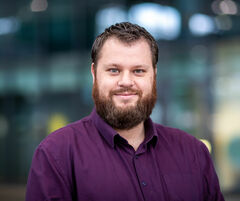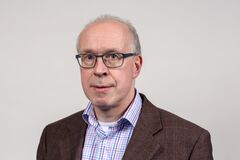
Full speed ahead on recruiting master’s students Beethoven
Recruitment of additional master's students for Beethoven project takes shape at Mechanical Engineering
Almost doubling the number of master’s students: that is the goal the Department of Mechanical Engineering is expected to achieve by around 2030. But where will they find the students? In higher vocational education (HBO), for instance, or abroad. “That final step towards doubling the numbers will be a quite a challenge.”
As one of the “Beethoven departments,” Mechanical Engineering (ME) has been tasked with attracting a large number of additional master’s students. The department currently has around 900 master’s students. By 2030, that number should be approximately 1,800. For now, however, there has been a slight drop.
This is partly due to population decline in the region and government measures against international student recruitment, explains Hans Kuerten: “For quite some time, we were not allowed to recruit students from abroad.” As part of Project Beethoven, the professor is responsible for educational development and student recruitment within the department. For both of these areas, he works together with Yves Houben, who leads the education marketing working group at ME on behalf of ESA.
Despite the current disappointing recruitment figures, neither of them is worried. “We know the reason for it,” says Kuerten, alluding to national agreements that hamper the recruitment of international students. “If we were allowed to resume our recruitment efforts from before those agreements, we could quickly reach our former numbers again. Even so, we still need to roughly double the number of students, so that will definitely require a considerable extra effort.”
It’s full speed ahead on multiple fronts. Twenty “target countries” have been identified for the recruitment of additional international students. The university plans to launch recruitment campaigns in those countries. For three of them, TU/e will do so in collaboration with other universities. Houben says it’s important to tailor those campaigns not only to the students’ initial interest, but also to what comes next. “It’s about the complete story – from sparking interest to onboarding. We must ensure that all our information is accurate, readily available and to the point, and that we are available for personal contact. There’s a lot of demand for the latter.”
HBO
But new students can also be found closer to home – in higher vocational education (HBO), for example. There are two ways for HBO students to enter a university master’s program at TU/e: by completing a premaster, or through the HBO-TOP program. Both options come with a considerable drawback, says Kuerten: they are 30-credit programs –the equivalent of a semester – but they take an entire year to complete. “We’re looking into the possibility of redesigning the programs so that they fit within a single semester.”
Such changes are possible thanks to funding from Project Beethoven, Houben adds. For example, the new programs would require a new math course and HBO-TOP students would need more guidance from the university. That requires additional temporary staff. The same goes for the development of new master’s tracks. These tracks are being developed in part to meet regional demand for specific specializations. By appointing temporary staff to, for example, take over teaching duties, the permanent staff can focus on developing the tracks.
Robots
The new master’s tracks could help attract more students, Kuerten thinks. He mentions an example of students leaving TU/e after completing their bachelor’s because they didn’t think TU/e had anything to offer in the field of robotics. “Of course it does. We actually work with robots a lot here, but that wasn’t clearly visible. It’s partly for this reason that a Robotics section has been set up, along with a new master’s track to improve that visibility.”
The new specializations may be appealing to master’s students from other universities both here in the Netherlands and abroad, but they may also make it more attractive for TU/e’s own bachelor’s students to stay. There is still a lot to be gained in that area. While the retention rate among Dutch bachelor’s students in Mechanical Engineering is already very high – “about eighty percent stay at TU/e,” Houben explains – “among international students, it’s only about one-third.” If international students are properly informed about what TU/e’s master’s programs have to offer, he thinks there is still potential for growth in that group.
At home in Eindhoven
What is even more important for this, according to Kuerten, is that students feel at home in Eindhoven. To ensure this, they need to start off on the right foot in their first few weeks. “That’s where things go wrong sometimes, for example if there are not enough seats in the lecture hall. And housing is a big problem as well.” Once those things are solved and processes run more smoothly, he believes more students will want to stay in Eindhoven for their master’s programs.
We have plenty to want to stay for, he adds. “TU/e rivals the most prestigious universities in the world. That’s something we tend to forget here – how good we are.” Studying at a highly regarded university increases your chances of landing a job, he acknowledges, but he adds that TU/e’s reputation is just as strong with companies. Houben laughs: “At TU/e, you don’t need to worry about finding a job, but rather about choosing which one you want.”
The last ten percent
Will it be possible to realize this doubling of student numbers through increased retention and other measures? A fair portion will be achieved, thinks Houben, but he says the greatest difficulty lies in the last ten percent of the growth. “The further you get, the harder it becomes to reach even more people.” The pool of potential students simply becomes exhausted at a certain point. And then, the only way to recruit more master’s students is through a long-term effort. Kuerten: “If we managed to enthuse a larger proportion of secondary school students about technology, that would obviously help a lot.”
To that end, he believes technology should be made more appealing to students in the lower grades of secondary school, and even before that. “For example, girls are often told that technology isn’t for them, but that’s not true at all. There’s still a lot of room for improvement there.” To promote technology among younger students as well, TU/e has several initiatives, such as a subject support center set up by people from Applied Physics and activities organized by the pre-TU/e group. However, these initiatives will obviously not bring in master’s students before 2030, the professor acknowledges. “That’s something for the long term.”
Beethoven departments
Mechanical Engineering is not the only department that needs to recruit additional master’s students. The same is true for Applied Physics and Science Education, Electrical Engineering and Mathematics and Computer Science. Those three departments have their own “Kuerten and Houben.” There is a lot of collaboration between the Beethoven departments. “I meet with my colleagues weekly on this topic,” Houben says. “We’d like to handle recruitment together and we’re also willing to share staff.” There is an overarching task force for student recruitment as well, which Kuerten is a member of. He is also on the task force for educational development. There is a lot of overlap between the two groups, both in terms of content and members.



Discussion